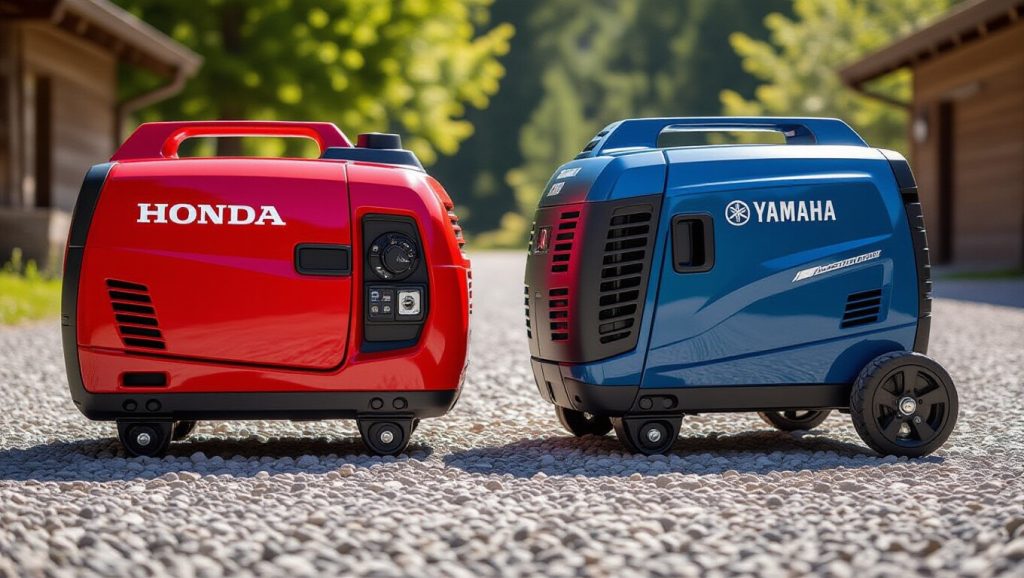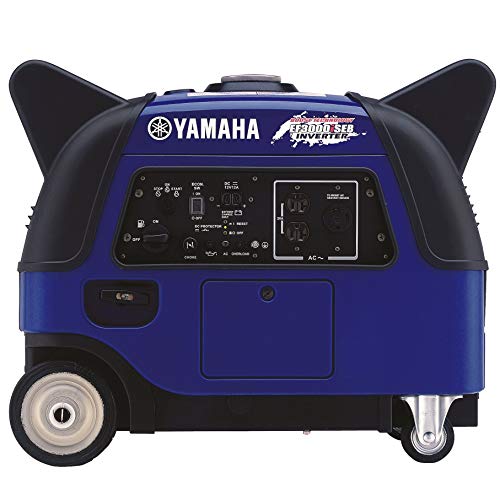Last Updated on August 6, 2025
Choosing between Honda and Yamaha generators depends on your priorities. Honda offers quieter operation, advanced safety features like CO monitoring, and a broader model range with higher build quality, ideal for long-term reliability and sensitive electronics.
Yamaha delivers rugged durability, longer runtimes, better fuel efficiency, and easier portability at a more affordable price. Both provide clean inverter power, but their unique strengths suit different uses.
Exploring their detailed differences can help you find the perfect match for your needs.
- This popular model can operate a wide variety of appliances, making it perfect for portable use at…
- So quiet, your neighbors will thank you. The EU2200i operates at 48 to 57 dBA, which is less noise…
- Add a second EU2200i for additional power. Two identical models can be paralleled with an optional…
- Powerful Yamaha 79cc Engine – Provides high power output.
- Yamaha Quiet Technology – Outfitted with Yamaha sophisticated muffler for quiet operation.
- Standard RV Outlet – No more searching for the right adapter. DC Outlet – Flexibility to charge and…
Key Takeaways
- Honda generators offer superior build quality, advanced safety features like CO sensors, and quieter operation with compact, vibration-dampened engines.
- Yamaha generators provide longer runtimes, larger fuel tanks, and built-in wheels for enhanced portability and convenience during extended use.
- Both brands deliver clean inverter power, but Honda supports parallel operation for increased output, which Yamaha models generally lack.
- Yamaha models are typically more affordable with practical features like Smart Throttle and fuel drain switches for improved fuel efficiency.
- Honda generators are lighter and easier for solo transport, while Yamaha units are heavier but designed for rugged durability and easier movement with wheels.
Yamaha vs Honda Generator: Comparison Table
| Feature | Honda | Yamaha |
|---|---|---|
| Build Quality | Premium materials, aluminum bores, advanced coatings | Rugged construction, cast iron bores, metal camshaft |
| Durability | Built for long-term reliability | Designed for high heat tolerance and tough conditions |
| Noise Level | Quieter operation (under 60 dBA) | Slightly louder (~59.5–65 dBA) at load |
| Portability | Lightweight (~46.5 lbs), single handle for solo carry | Heavier (~55 lbs), tri-handle and built-in wheels |
| Fuel Efficiency | Up to 8.1 hours runtime (¼ load), Eco-Throttle system | Up to 10.5 hours runtime (¼ load), Smart Throttle |
| Tank Size | 3.6L fuel tank | 4.7L fuel tank |
| Safety Features | CO Minder technology, covered outlets, overload protection | CO alert (no shutdown), GFCI outlets, overload auto-reset |
| Power Output Range | Broad range: 1,000W to 10,000W | Focused range: 2,000W to 7,200W |
| Parallel Operation | Supported across compatible models | Limited/Not typically supported |
| Usability | User-friendly controls, low vibration, compact design | Tool-free access, LED control panel, larger footprint |
| Best For | Home backup, sensitive electronics, quiet environments | Outdoor use, camping, extended runtime on budget |
| Maintenance | Regular oil/filter changes, valve checks every 250 hours | Oil/filter changes, fuel filter cleaning, easy access |
| Unique Tech | Digital AVR, Eco-Throttle, CO Minder | Smart Throttle, Boost mode, fuel drain switch |
Brand History and Market Reputation
Although both Honda and Yamaha have deep roots in Japanese industry, their paths to becoming leaders in the generator market reflect distinct histories and reputations.
Honda started in 1946 as a small workshop focusing on motorized bicycles and quickly innovated with its own auxiliary engine by 1947. By 1964, it was the world’s largest motorcycle maker and entered the U.S. power equipment market in 1973, pioneering portable generators with advanced inverter technology by the late 1990s.
Honda evolved from motorized bicycles in 1946 to pioneering portable inverter generators by the late 1990s.
Yamaha, founded in 1887 as a musical instrument maker, diversified into motorcycles in the 1950s and later power products. Yamaha generators emphasize rugged durability, quiet performance, and fuel efficiency, appealing to outdoor and commercial users.
Both brands maintain strong global presences but cater to slightly different market priorities.
Power Output and Model Range Comparison
You’ll find that both Honda and Yamaha offer generators with similar power capacities, typically maxing out around 2200 watts for popular portable models. Consider factors like durability and performance when comparing these brands to ensure long-lasting use.
However, Honda’s lineup is particularly broader, spanning from compact units to industrial-grade generators with outputs exceeding 10,000 watts. Understanding these differences in model diversity helps you choose a generator that fits your specific power needs and application.
Additionally, Honda’s engines generally have a higher displacement of 121 CC compared to Yamaha’s 79 CC, which can translate to more consistent and reliable power delivery.
Power Capacities Overview
When comparing the power capacities of Honda and Yamaha generators, you’ll find both brands offer models that cover a wide range of needs, from portable units to high-power industrial machines.
Honda generally provides higher maximum outputs, especially in industrial models, while Yamaha excels in fuel efficiency at mid-range capacities with smart throttle technology.
Both brands deliver clean, inverter-based power suitable for sensitive electronics and reliable performance under various load conditions.
| Model Range | Honda Output (Watts) | Yamaha Output (Watts) |
|---|---|---|
| Portable (EU2200i/EF2200iS) | 2,200 max / 1,800 rated | 2,200 max / 1,800 rated |
| Mid-Range (EG2800i/EF2800i) | 2,800 max / 2,500 rated | 2,800 max / 2,500 rated |
| Industrial (EB10000/EF7200D) | 10,000 max | 7,200 max |
Yamaha’s models also feature a longer runtime at ¼ load, offering up to 10.5 hours runtime, which can be advantageous for extended use without refueling. This range offers you options tailored to various power requirements.
Model Diversity Comparison
Since both Honda and Yamaha target different user needs, comparing their model diversity reveals distinct approaches to power output and range.
Honda’s lineup spans from lightweight 1000-watt portable units to robust models exceeding 7000 watts, offering inverter technology with clean power ideal for sensitive electronics. Their models often incorporate advanced technology for enhanced performance and reliability.
Yamaha focuses on portable inverter generators between 2000 and 6000 watts, emphasizing quiet operation and fuel efficiency, alongside heavier conventional models like the EF7200DE for high power demands. Their generators tend to be about 18-19% louder than Honda, which may influence user preference depending on noise sensitivity.
Honda’s eco-throttle and CO-sensor features enhance efficiency and safety, while Yamaha prioritizes portability with built-in wheels and compact designs. Interestingly, Honda supports parallel operation for output flexibility, a feature Yamaha lacks.
Your choice depends on whether you need a broad power spectrum with advanced tech (Honda) or specialized portable, quiet units with some heavy-duty options (Yamaha).
Noise Levels and Portability Factors
Although both Honda and Yamaha generators offer quiet operation, their noise levels and portability features differ in ways that could influence your choice.
Yamaha’s EF2200IS operates around 57 to 65 dBA, benefiting from a spark arrestor and unique muffler design, making it nearly silent at distance. Noise measurements taken at a consistent 23-foot distance confirm Yamaha’s quietness, with levels near 59.5 dB at low load. Both brands incorporate inverter technology to ensure efficient and quieter performance.
Honda’s EU2200i, with lower idle speeds, also stays under 60 dBA at typical distances, though its noise metric differs. The larger engine in Honda contributes not only to performance but also to its quieter operation under load.
When it comes to portability, Yamaha is heavier (about 55 lbs) but sports a tri-handle for easier two-person carrying, while Honda weighs roughly 46.5 lbs with a single handle, favoring solo transport. Proper handling and storage of portable equipment like generators are important for maintaining performance and safety.
Both use inverter technology to reduce noise under partial load, but your preference between Yamaha’s muffler maintenance and Honda’s lighter frame will guide which suits your noise tolerance and transport needs best.
Build Quality and Durability Assessment
Delving into build quality and durability, you’ll find that Honda and Yamaha take distinct approaches in engine construction and materials that directly affect longevity and performance.
Honda uses aluminum bores with advanced coatings like Nikasil, promoting wear resistance, while Yamaha’s cast iron bores and metal camshafts favor rugged durability. Honda’s plastic components may risk failure under high heat, whereas Yamaha relies on metal parts to reduce weak points.
Additionally, Yamaha’s design incorporates four built-in wheels for easier movement, reflecting a practical approach to portability. Understanding the impact of material choice on long-term maintenance can guide your decision.
| Aspect | Honda | Yamaha |
|---|---|---|
| Engine Material | Aluminum bores, plastic parts | Cast iron bores, metal parts |
| Structural Design | Compact, vibration-dampened frame | Larger, heavier, robust frame |
| Durability Focus | Long service life with care | High heat tolerance, rugged use |
Key Features and Usability Differences
Beyond build quality and durability, understanding the key features and usability distinctions between Honda and Yamaha generators helps you match a model to your specific needs.
Yamaha excels in fuel efficiency with longer runtimes—up to 14.7 hours on the EF2800i—thanks to its Smart Throttle, which adjusts RPMs to load. However, Yamaha’s larger size and heavier weight can make storage and portability more challenging compared to Honda’s lighter and more compact design.
Honda counters with an Eco-Throttle system but lacks Yamaha’s fuel drain switch. Both brands offer comparable power outputs and low THD, safe for sensitive electronics, with Yamaha’s EF2200i providing a temporary boost mode for startup surges.
Efficient power management systems like these contribute to better overall fuel consumption and quieter operation. In terms of noise, Honda is slightly quieter, ideal for noise-sensitive settings. Yamaha’s open outlet design contrasts with Honda’s covered outlets, and Yamaha includes an overload auto-reset feature.
Honda’s smaller, lighter frame enhances portability, while Yamaha bundles a parallel kit for ease of dual-unit operation. Easy installation and compatibility of accessories can improve the overall user experience significantly.
Performance With Sensitive Electronics
Although both Honda and Yamaha generators deliver clean, stable power suitable for sensitive electronics, subtle differences in their output quality and voltage regulation can influence device safety and performance.
Yamaha models typically offer lower Total Harmonic Distortion (THD), enhancing power purity, while Honda utilizes Digital AVR technology for precise voltage control, reducing spikes.
Both brands maintain frequency stability, critical for smooth device operation, and support parallel operation for scalable clean power.
Yamaha’s Smart Throttle system adjusts engine speed based on load to improve fuel economy and reduce noise. Noise levels differ slightly, affecting user comfort rather than electronic safety.
Choosing a generator with stable voltage regulation is crucial for protecting sensitive devices from power fluctuations.
Fuel Efficiency and Runtime Considerations
Since fuel efficiency directly impacts how long your generator can run between refills, compare Yamaha and Honda models on this front.
Yamaha generators typically feature larger fuel tanks—like the EF2200iS’s 4.7 litres versus Honda EU2200i’s 3.6 litres—resulting in longer runtimes. Yamaha’s EF2200iS runs up to 10.5 hours at ¼ load, while Honda’s offers 8.1 hours.
Both brands incorporate energy-efficient technology that optimizes fuel use during operation.
Both brands use inverter technology and throttle systems—Yamaha’s Smart Throttle and Honda’s Eco-Throttle—to optimize fuel consumption by adjusting engine speed based on load.
Real-world tests indicate that Yamaha’s smaller engine and higher operating RPM contribute to better fuel efficiency at certain load levels. Real-world tests show marginal differences in fuel efficiency, with Honda slightly outperforming Yamaha in some cases.
Safety Features and User Protection Mechanisms
Fuel efficiency affects more than just runtime; it also ties into how safely you can operate your generator over extended periods.
Honda’s CO Minder technology actively monitors carbon monoxide levels and shuts off the generator at dangerous thresholds, while Yamaha alerts you without automatic shutdown. Honda’s updated EU2200i model includes CO monitoring as a key safety enhancement introduced in 2021.
For electrical safety, Yamaha’s EF2800i includes GFCI outlets that cut power upon fault detection, reducing shock risk, whereas Honda relies on covered outlets to protect against dust. Both brands incorporate overload protection to prevent damage from excessive electrical loads.
Yamaha’s LED-illuminated control panel enhances visibility and reduces user error, complemented by tool-free maintenance access.
Both brands offer overload protection Honda requires manual shutdown, Yamaha allows reset without stopping. Their eco-throttle switches lower engine stress and noise, indirectly boosting safety.
Yamaha’s durable engine components add mechanical reliability, while Honda’s compact, low-vibration design minimizes physical hazards during operation.
Frequently Asked Questions
Are Replacement Parts for Honda or Yamaha Generators Easier to Find?
You’ll find that over 90% of common replacement parts, like spark plugs and filters, are stocked locally for easier access. This means you won’t face long waits when maintaining your generator.
The broad dealer network ensures quick repairs without hassle. In contrast, many parts require online ordering, causing delays.
How Do Honda and Yamaha Generators Perform in Extreme Weather Conditions?
You’ll find that both generators handle extreme weather well but with nuances. In cold weather, Honda’s larger engines and oil sensors aid reliable starts, while Yamaha’s smaller engines might struggle a bit.
For heat, Yamaha’s slightly bigger fuel tank helps longer runs, though both can face voltage drops. Humidity won’t easily affect either due to sealed components, but neither has specific anti-corrosion coatings.
At altitude, expect reduced power; Honda’s torque edges out slightly.
Can Either Brand’s Generators Be Connected in Parallel for Increased Power?
You can connect generators in parallel only if they’re the same model or designed as companion units. Parallel operation requires inverter generators with matching voltage and amperage, using manufacturer-specific parallel kits.
Mixing brands is risky due to different wiring and grounding schemes, which can cause damage or synchronization issues. Always follow the owner’s manual and use dedicated parallel cables.
For safe, efficient power increase, stick to identical or approved generator pairs.
What Are the Typical Maintenance Requirements for Each Brand’s Generators?
You’ll change oil regularly, clean air filters often, and inspect spark plugs carefully to keep your generator running smoothly. For Honda, oil changes come after 20 hours, then every 50 hours or six months, with valve and combustion chamber checks every 250 hours.
Yamaha calls for oil changes every 50 hours or annually, plus fuel filter cleaning. Both brands recommend fuel stabilizers during storage and frequent air filter maintenance in dusty conditions.
Built to Last: Premium Quality from Both Brands
When choosing between Honda and Yamaha generators, you’re really picking between two seasoned professionals. Honda’s quiet confidence suits those valuing smooth, reliable power, while Yamaha brings a spirited edge with versatile features.
Both offer solid build quality and thoughtful safety measures, so you won’t go wrong. Your choice boils down to subtle preferences in noise, fuel efficiency, and budget. Either way, you’re investing in dependable energy that won’t leave you in the dark.
- MORE POWER. SAME LEGENDARY QUALITY. – The EU2200i delivers 10% more power than the previous EU2000i…
- The Boost Control Unit (BCU) senses when extra power is needed and boosts output for up to 10…
- Sound absorbing material, used in key locations, does not resonate sound. Newly designed muffler and…
- Greater fuel efficiency and noise reduction by automatically adjusting engine speed to match the…
Last update on 2025-11-25 / Affiliate links / Images from Amazon Product Advertising API







